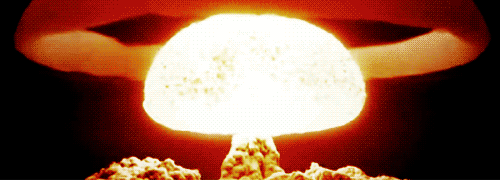
Members:
- Web Designer- Chris Pinkston
- Research Providers-
- Lucas Ferreira (Science)
- Deante Harris (research)
- Michael Vargas (Science)
- Eduardo Zamora (research)
- Chris Pinkston (Home Page)
- Presenter-
- Michael Vargas
- Deante Harris
Late in the war the Allies had begun to prepare for a costly invasion of Japan, to follow the firebombing campaign that destroyed many Japanese cities. The war in Europe ended when Nazi Germany signed its instrument of surrender on May 8, 1945, but the Pacific War continued. Together with the United Kingdom and China, the United States called for the unconditional surrender of the Japanese armed forces in the Potsdam Declaration on July 26, 1945, threatening "prompt and utter destruction".
By August 1945, the Allied Manhattan Project had successfully tested an atomic device and had produced weapons based on two alternate designs. The 509th Composite Group of the U.S. Army Air Forces was equipped with a Silverplate Boeing B-29 Superfortress that could deliver them from Tinian in the Mariana Islands. A uranium gun-type atomic bomb (Little Boy) was dropped on Hiroshima on August 6, 1945, followed by a plutonium implosion-type bomb (Fat Man) on the city of Nagasaki on August 9. Within the first two to four months of the bombings, the acute effects killed 90,000–166,000 people in Hiroshima and 60,000–80,000 in Nagasaki; roughly half of the deaths in each city occurred on the first day. During the following months, large numbers died from the effect of burns, radiation sickness, and other injuries, compounded by illness. In both cities, most of the dead were civilians, although Hiroshima had a sizeable garrison.
Much of the city has been reconstructed since then. But a gutted section has been set aside as a "Peace City" to illustrate the effect of an atomic bomb. Since 1955 an annual world conference against nuclear weapons has met in Hiroshima. Hiroshima prefecture (1990 pop. 2,849,822), 3,258 sq. mi (8,438 sq. km), is generally mountainous, with fertile valleys. Rice and oranges are grown extensively, cattle are raised, textiles are manufactured, and shipyards are plentiful.
Timeline:
- July 16,1945- First nuclear test in history conducted by the United States (Alamogordo, New Mexico). USS Indianapolis leaves San Francisco for Tinian Island in the Marianas (via Hawaii). Cargo: Portions of uranium 235 and atomic bomb to be dropped on Hiroshima. Scheduled to arrive on July 26. (Other portions of uranium 235 and bomb parts were transported in separate shipments.)
- July 17-August 2,1945 - President Truman attended conference at Potsdam, to discuss post-war treatment of Germany with Premier Joseph Stalin of Russia and Prime Minister Winston Churchill of Great Britain.
- July 24, 1945 - At the Potsdam Conference, President Truman told Stalin only that the U.S. "had a new weapon of unusual destructive force." This is often considered the start of "atomic diplomacy."
- July 26,1945 - Potsdam Declaration announced in United States, United Kingdom and China, asking for unconditional surrender of Japanese.
- July 28,1945 - Japan announces it will ignore the Potsdam Declaration.
- August 6,1945 - A Uranium bomb is dropped and explodes on Hiroshima.
- August 9,1945 - A Plutonium bomb dropped on Nagasaki.
- August 10,1945 - Japan protests new type of weapon as violation of international law.
- August 15,1945 - Japan accepts the Potsdam Declaration (Surrenders unconditionally to the Allied Forces).
